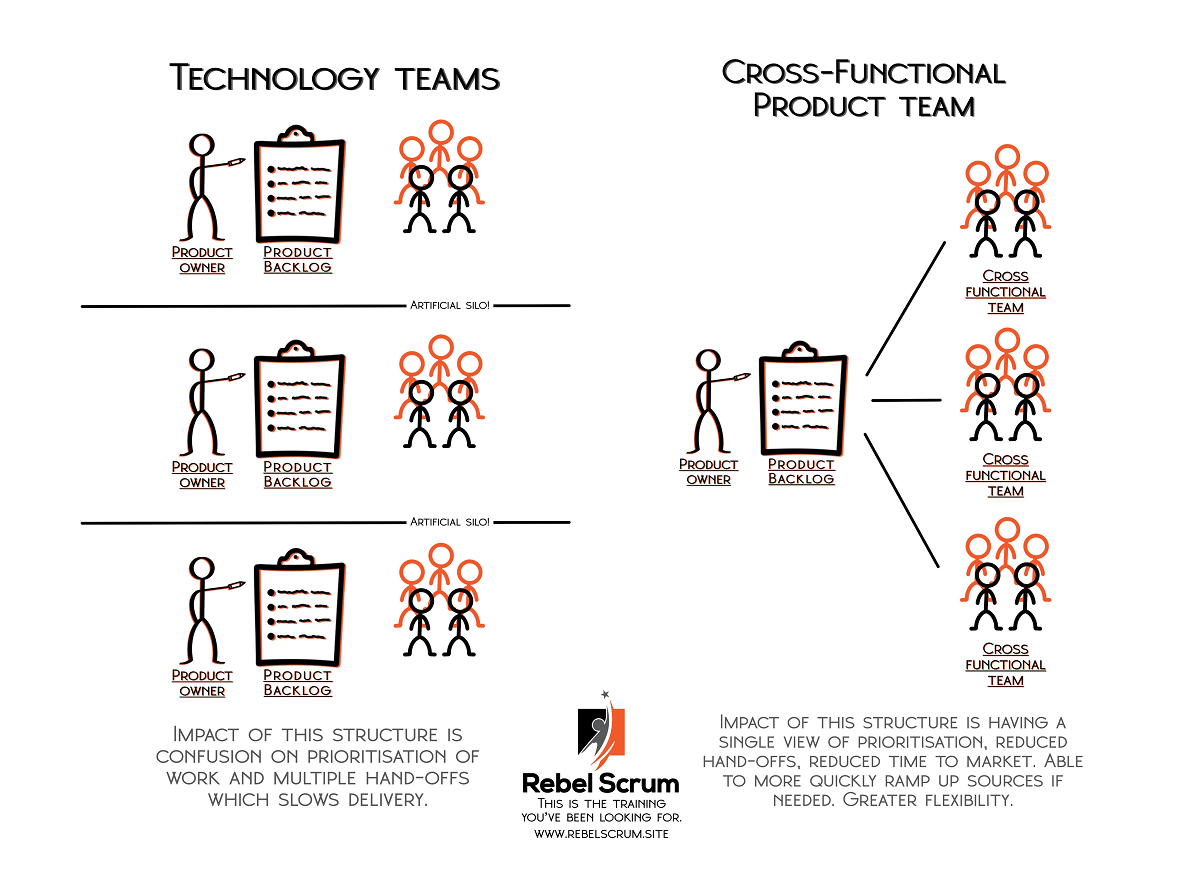A central feature of the Scrum framework is the concept of a cross-functional team. But what exactly is cross-functionality, and how is it beneficial? Let's explore this topic in an agile software development context.
Traditional project management approaches often organize teams based on specialized roles and responsibilities. You have developers who write code, testers who ensure quality, designers who create user interfaces, etc. Each team member has a specific area of expertise and tends to work within their silos.
In Scrum, the emphasis is on collaboration and flexibility. In this context, a cross-functional team refers to a group of individuals with diverse skills and expertise necessary to complete a software project. These teams self-organize and self-manage and are empowered to make decisions collectively.
Let’s break down the critical characteristics of a cross-functional team:
Diverse Skill Sets: Cross-functional teams comprise individuals with various skills and competencies. This could include developers, testers, designers, business analysts, and other roles needed to deliver a product increment.
Shared Responsibility: In a cross-functional team, members share the responsibility for achieving the team's goals. Instead of assigning tasks to specific individuals based on their roles, the team collectively decides how to distribute the work best and ensures that each member contributes to the overall success.
Collaborative Mindset: Collaboration is a fundamental aspect of cross-functional teams in Scrum. Team members work together closely, leveraging their unique skills to achieve shared objectives. They actively communicate, share knowledge, and help each other, fostering a culture of teamwork and collective ownership.
T-shaped Skills: While each team member may have a primary area of expertise, they also possess a broader understanding of other disciplines. This T-shaped skill set allows team members to collaborate effectively and support each other as needed, ensuring a smooth workflow and reducing dependencies.
Autonomy and Empowerment: Cross-functional teams are empowered to make decisions and adapt to changing requirements. They can choose how to accomplish their work, allowing flexibility and creativity in finding the best solutions.
The benefits of a cross-functional Scrum Team are numerous. By bringing together individuals with different skills and perspectives, these teams promote innovation, problem-solving, and a holistic approach to project delivery. They reduce handoffs, bottlenecks, and communication barriers often plaguing traditional development models.
Moreover, cross-functional teams enable faster feedback cycles and facilitate continuous improvement. With all the necessary skills in one team, there's no need to wait for handoffs or external dependencies. This enables quicker decision-making, faster iterations, and the ability to respond to customer feedback promptly.
In short, being a cross-functional Scrum Team means having a group of individuals with diverse skills, a shared sense of responsibility, and a collaborative mindset. They work together autonomously, leveraging their varied expertise to deliver high-quality software increments. This approach fosters creativity, agility, and efficiency, allowing teams to adapt and thrive in the ever-changing software development landscape.
Cross-functional teams myths
Cross-functional teams have become a popular and widely adopted approach in modern workplaces. However, myths and misconceptions surrounding cross-functionality often hinder its successful implementation. I’m going to debunk the most common myths about cross-functional teams and shed light on the reality of their benefits and challenges.
Myth 1: Cross-functional teams are chaotic and lack structure.
Reality: While cross-functional teams embrace flexibility and collaboration, it doesn't mean they lack structure. Successful cross-functional teams thrive on clear goals, defined accountabilities, and processes established by the team. They leverage frameworks such as Scrum or Kanban to maintain organization and ensure coordination and management of that work. By having a shared understanding of their objectives and responsibilities, cross-functional teams can operate in a structured manner while enjoying the benefits of collaboration and adaptability.
Myth 2: Cross-functional teams are difficult to manage.
Reality: Managing cross-functional teams requires a different approach than traditional hierarchical management styles. However, that doesn't make them inherently more challenging to manage. Effective management of cross-functional teams involves providing clear direction, facilitating communication and collaboration, and empowering team members to make decisions. It's about creating an environment that fosters autonomy, trust, and continuous learning. When managed well, cross-functional teams can bring out the best in each team member and drive successful outcomes.
Myth 3: Cross-functional teams slow down decision-making.
Reality: On the contrary, cross-functional teams can expedite decision-making processes. By bringing together individuals with diverse skills and expertise, cross-functional teams have the advantage of multiple perspectives. This diversity leads to more robust discussions and faster problem-solving. Instead of waiting for approvals or involving various departments, decision-making can happen directly within the team, enabling quicker responses to challenges and changes. When empowered with clear decision-making guidelines, cross-functional teams can make informed, timely decisions that keep projects moving forward.
Myth 4: Cross-functional teams lead to conflicts and a lack of accountability.
Reality: Conflict can arise in any team, regardless of its structure, but cross-functional teams often have built-in resolution mechanisms. Conflicts are addressed constructively by encouraging open communication and fostering a culture of respect and collaboration. Cross-functional teams also promote a shared sense of accountability, as team members collectively work towards the team's goals. When everyone is aware of their responsibilities and the impact of their work on the overall project, accountability naturally rises.
Myth 5: Cross-functional teams eliminate the need for specialists.
Reality: Cross-functional teams are not meant to replace specialists or their expertise. Instead, they aim to leverage and integrate specialized knowledge within the team. While team members may possess a broad range of skills, they still maintain their areas of expertise. Cross-functional teams promote a T-shaped skill set, where team members have deep knowledge of their specialization and a working understanding of other disciplines. This allows teams to collaborate effectively, share knowledge, and support one another while benefiting from specialized expertise when needed.
Summing up, cross-functional teams have structure and do not impede decision-making or accountability. We can embrace their value by dispelling these myths while fostering collaboration, innovation, and adaptability. When properly managed and supported, cross-functional teams can lead to improved project outcomes, increased employee engagement, and a culture of continuous improvement.
How to build a cross-functional team
Building genuinely cross-functional Scrum Teams starts with product definition. This means identifying and understanding the scope, requirements, and goals of the product the team will work on. By doing so, the team can bring together all the skills necessary to deliver that product or add value to an existing one.
Defining the product allows the team to have a shared understanding of what they are working towards. It helps them identify the skills and expertise required to achieve the desired outcomes. For example, if the product involves developing a mobile application, the team would need individuals with mobile development expertise, UI/UX design skills, backend development capabilities, and possibly marketing knowledge to ensure a successful launch.
When the product is well-defined, the team can plan and organize themselves accordingly. They can assess the skills and capabilities available within the team and identify any gaps that must be addressed. This may involve cross-training team members, acquiring new talent, or collaborating with external resources to fill those gaps.
Defining the product also helps in breaking down silos and encouraging collaboration. When team members clearly understand the overall product and its objectives, they can contribute beyond their specialized roles. They can share knowledge, provide insights, and assist other team members, fostering a true cross-functional environment.
Moreover, the team can work collaboratively to create a Product Backlog that represents the desired features and functionalities. They can prioritize items based on value, complexity, and dependencies by having a shared understanding of the product vision. This collectivity ensures that the work undertaken by the team aligns with the overall product goals and maximizes the value delivered to the stakeholders. For more in product definition in the context of transitioning a new team to Scrum, check out our recent article How to roll-out Scrum in your organization.
Conclusion
For a Scrum Team to be genuinely cross-functional, defining the product they are working on is crucial. Product definition allows the team to bring together all the skills and expertise required to deliver or enhance the product's value. This shared understanding enables the team to collaborate effectively, plan their work, and prioritize tasks to align with the product's goals.
Join us for this year’s Scrum Day Conference, scheduled for September 14, 2023. This highly anticipated event brings together agile enthusiasts, Scrum practitioners, and industry experts from around the world. With an emphasis on teamwork and collaboration, the conference aims to explore the profound impact of Agile frameworks in fostering effective and high-performing teams. Attendees can expect engaging keynote presentations, interactive workshops, and insightful panel discussions that delve into the principles, practices, and success stories of Scrum. This year’s Scrum Day Conference promises to be a dynamic platform for knowledge sharing, networking, and discovering innovative approaches to maximize the potential of teams in achieving exceptional results.


